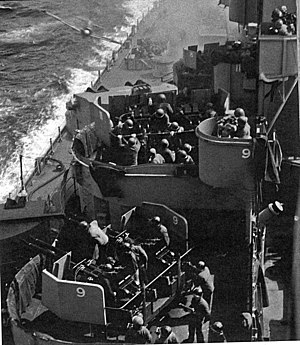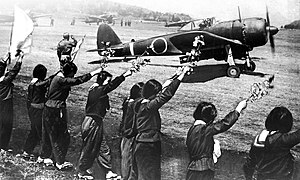Japanese Special Attack Units



This article needs additional citations for verification. (October 2009) |
You can help expand this article with text translated from the corresponding article in Japanese. (February 2018) Click [show] for important translation instructions.
|
During World War II, Japanese Special Attack Units (特別攻撃隊, tokubetsu kōgeki tai, often abbreviated to 特攻隊 tokkōtai), also called shimbu-tai, were specialized units of the Imperial Japanese Navy and Imperial Japanese Army normally used for suicide missions. They included kamikaze aircraft, fukuryu frogmen, and several types of suicide boats and submarines.
Background[edit]
Towards the end of the Pacific War, the Japanese were increasingly anticipating an American attack into the country and preparation was made for its defense.[1] This was called Ketsugō and the operation included the formation of specialized Japanese units. The move was driven by the realization that, in order to defend their homeland, conventional warfare was no longer sufficient.[1] The recruitment of soldiers willing to die in the suicide missions was, therefore, easily carried out. The suicide attack is also an accepted method of fighting and this is largely attributed to Japan's highly militaristic society as demonstrated by the samurai system with its bushido code, which established a legacy that honors and idealizes self-sacrifice.[2]
Japan saw the efficacy of the specialized units during their deployment in the Philippines in summer-fall 1944 when special attack units executed their first missions.[1] Japan saw that they were able to achieve results with limited resources.[3] Historians view the success of the suicide tactics as an important driver to Japanese war policies after 1943.
Aircraft[edit]
Ohka suicide rocket aircraft[edit]

The Yokosuka MXY-7 Ohka (櫻花, "cherry blossom") was a purpose-built kamikaze aircraft employed by the Imperial Japanese Navy Air Service towards the end of World War II. The US gave the aircraft the Japanese name Baka ("idiot").
It was a small flying bomb that was carried underneath a Mitsubishi G4M2e "Betty", Yokosuka P1Y Ginga "Frances" (guided Type 22) or planned Heavy Nakajima G8N Renzan "Rita" (transport type 33) bomber to within range of its target; on release, the pilot would first glide towards the target and when close enough he would fire the Ohka's engine(s) and dive onto the ship to destroy it. That final approach was almost unstoppable (especially for Type 11) because the aircraft gained tremendous speed. Later versions were designed to be launched from coastal air bases and caves, and even from submarines equipped with aircraft catapults, although none were actually used this way.
Shinryū[edit]
The Mizuno Shinryū (神龍, "Divine Dragon") was a proposed rocket-powered kamikaze aircraft designed for the Imperial Japanese Navy towards the end of World War II. It never reached production.
Tsurugi[edit]
The Nakajima Ki-115 Tsurugi (剣, "Sword") was a one-man kamikaze aircraft developed by the Imperial Japanese Army Air Force in the closing stages of World War II in late 1945.
Baika[edit]
The Kawanishi Baika (梅花, "Ume Blossom") was a pulsejet-powered kamikaze aircraft under development for the Imperial Japanese Navy towards the end of World War II. The war ended before any were built. The design was inspired by the manned version of the German V1 flying bomb, the Fieseler Fi 103R "Reichenberg".
Boats[edit]

Shin'yō and Maru-Ni[edit]
The Shin'yō (震洋, "Sea Quake") were Japanese suicide boats developed during World War II. They were part of the wider Special Attack Units program. These fast motorboats were piloted by one man, to speeds of around 30 kn (56 km/h; 35 mph). The Maru-Ni was an Army version with two depth charges the operator would drop and try to escape before detonation.
Around 6,200 Shin'yō were produced for the Imperial Japanese Navy and 3,000 Maru-Ni for the Imperial Japanese Army. Around 400 were deployed to Okinawa and Formosa, and the rest were stored on the coast of Japan for the ultimate defense against the invasion of the Home islands.
Submarines[edit]
Kaiten[edit]

The Kaiten (回天, variously translated as "Change the World", "Returning to Heaven" or "Heaven-shaker") was a torpedo modified as a suicide weapon, and used by the Imperial Japanese Navy in the final stages of World War II.
Early designs allowed for the pilot to escape after the final acceleration towards the target, although whether this could have been done successfully is doubtful. There is no record of any pilot attempting to escape or intending to do so, and this provision was dropped from later production kaitens. The inventor of the Kaiten, Lt. Hiroshi Kuroki was lost during one of the first training missions. When the sub was raised, a note written during his final minutes before death was found, sending his respects to his family and detailing the cause of the accident and how to repair the defect.
Kairyū[edit]

The Kairyū (海龍, "Sea Dragon") was a class of Suicide midget submarines of the Imperial Japanese Navy, designed in 1943–1944, and produced from the beginning of 1945. These submarines were designed to meet the invading American Naval forces upon their anticipated approach of Tokyo.
These submarines had a two-man crew and were armed with two torpedoes and an internal warhead for suicide missions. Over 760 of these submarines were planned, and by August 1945, 200 had been manufactured, most of them at the Yokosuka shipyard.
Divers[edit]
Suicide divers (伏龍, Fukuryū, "Crouching dragons") were a part of the Special Attack Units prepared to resist the invasion of the Home islands by Allied forces. They were armed with a mine containing 15 kg (33 lb) of explosive, fitted to a 5 m (16 ft) bamboo pole. They would dive and stick the pole into the hull of an enemy ship, destroying themselves in the process. They were equipped with a diving jacket and trousers, diving shoes, and a diving helmet fixed by four bolts. They were typically weighed down with 9 kg (20 lb) of lead, and had two bottles of compressed air at 150 bars. They were expected to be able to walk at a depth of 5 to 7 m (16 to 23 ft), for about six hours. Several deaths occurred during training due to malfunctions, but this weapon is only known to have been used a few times operationally:
- January 8, 1945: Damage by suicide divers to Infantry landing craft (gunboat) LCI(G)-404 in Yoo Passage, Palaus.
- February 10, 1945: Attempted attack by suicide divers on surveying ship USS Hydrographer (AGS-2) in Schonian Harbor, Palaus.
See also[edit]
- Banzai charge
- Chiran Special Attack Peace Museum
- Jibakutai
- Kaoru Special Attack Corps
- List of Imperial Japanese Army air-to-surface special attack units
- List of Imperial Japanese Navy air-to-surface special attack units
- Piso Point
- Suicide attack
References[edit]
- ^ a b c Rielly, Robin (2010). Kamikaze Attacks of World War II: A Complete History of Japanese Suicide Strikes on American Ships, by Aircraft and Other Means. Jefferson, NC: McFarland. pp. 301. ISBN 9780786446544.
- ^ Todd, Allan (2015). History for the IB Diploma Paper 1 The Move to Global War. Cambridge: Cambridge University Press. p. 31. ISBN 9781107556287.
- ^ Detweiller, Donald (1980). Naval Armament Vol. 1. Abingdon: Taylor and Francis. p. 13. ISBN 9780824032883.
